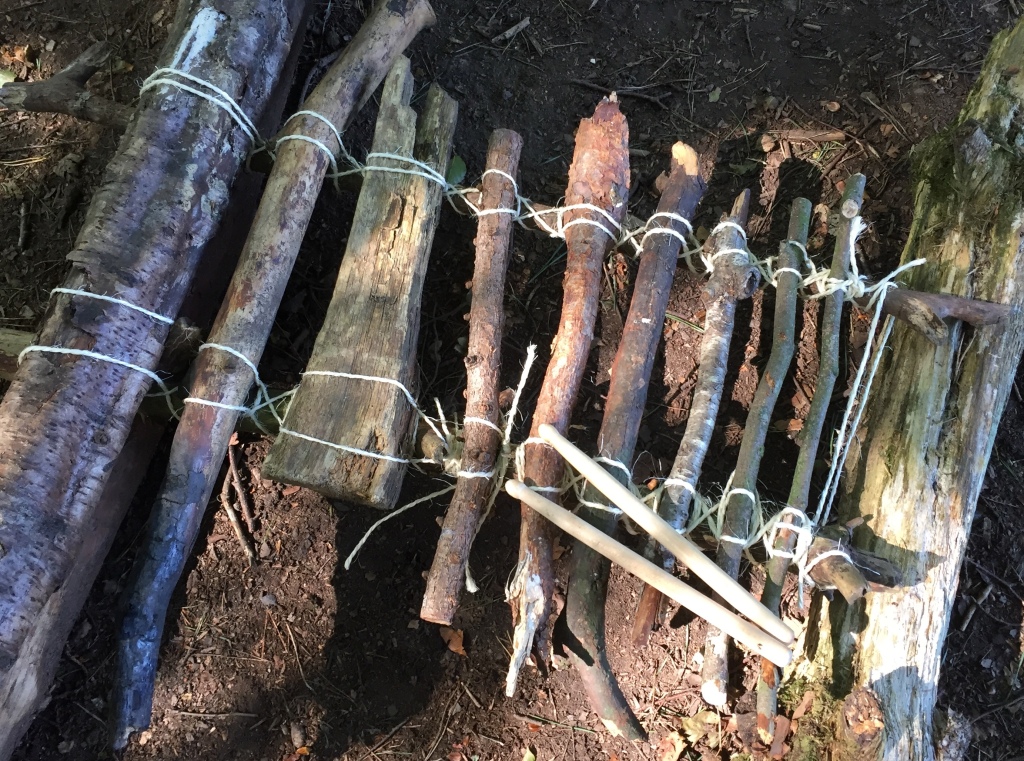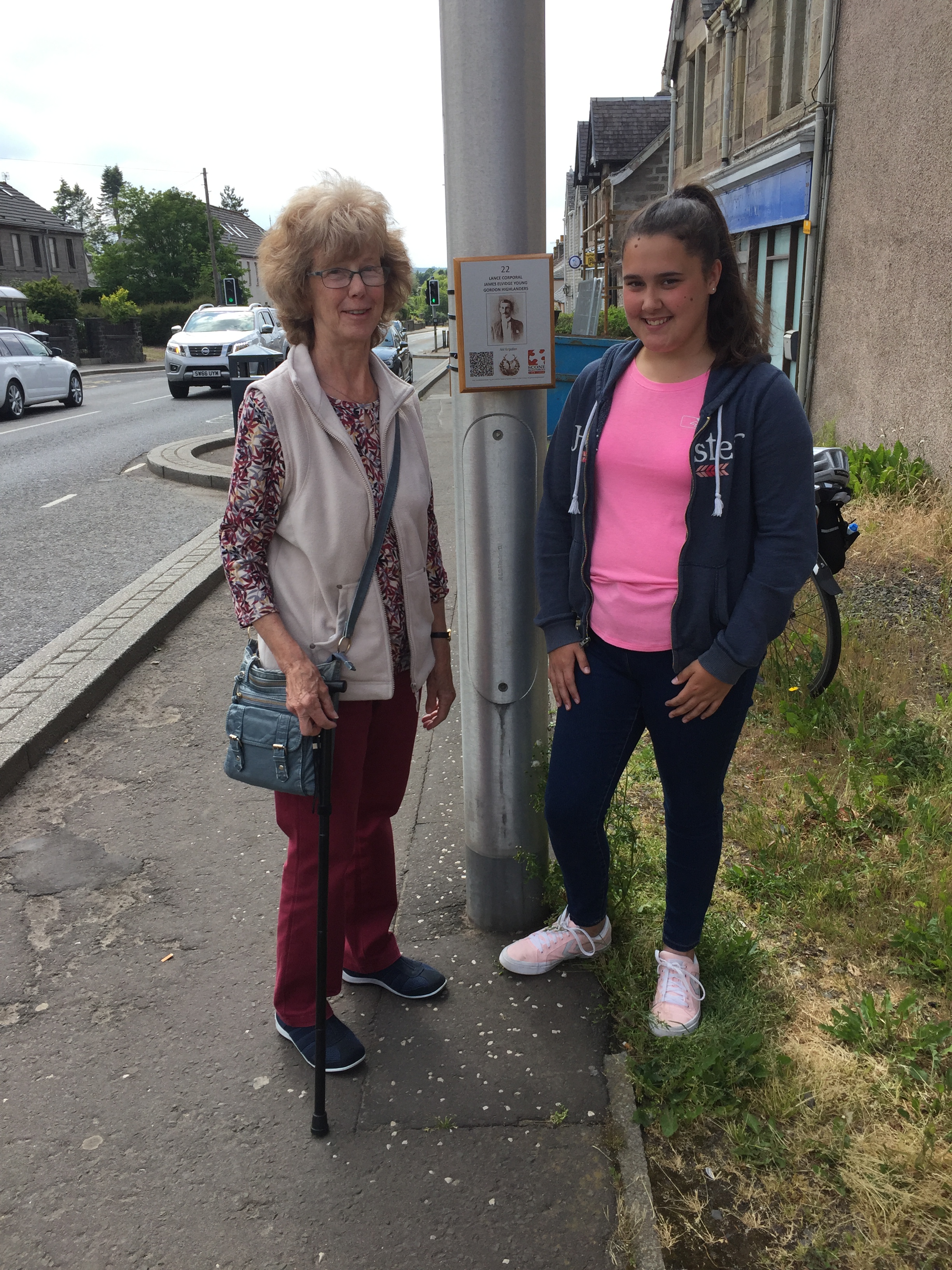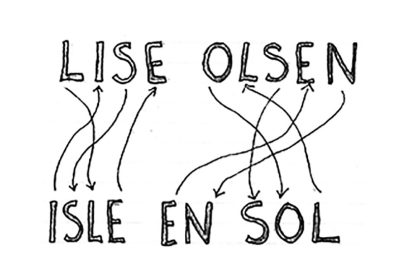This is the documentation of my sound Installation from the exposition I had at WASPS in Dundee. I not sure how I feel about it… The film does not feel as immersive as it did when listen to the sound under the canopy.
Category: Sound
Are There No Birds Singing In The Woods Today?
Listening: In-between Focusing and Blurring
“It is important to relize that focussing on something necessarily blurs something else…”[1] F.G Asenjo
I organised a sound activity for some of the children during the August session of Quarrymill Adventures. Each child was given a sound recorder and headphones, and asked to find and record different woodland sounds. RSPB Volunteer Katie, even helped to make a woodland xylophone for the children to play and record!

I asked one child to record the sound of a bird singing. After a few minutes, the child came running back and informed me that no birds were singing in the woods today. I was slightly baffled and I stopped for a moment to focus on listening for birds. I heard Crows’ cawing, a Robin chattering, and a Woodpigeon cooing in the distance.
“Can you hear the Crows?” I asked. “No, I can only hear the water from the burn and the wind in the trees,” they replied. I needed to focus the child’s attention so I looked up into the trees. I could see a Coal-tit sitting on a branch. “Can you see the bird in the tree? Listen! It is singing?” I questioned as I pointed towards the bird. “Yes, I hear it tweeting and moving on the twig,” the child replied, as they eagerly pressed the red button on the sound recorder.
I began to reflect on the child’s experience of recording sound. I wonder if the sound of birdsong is so frequent; the sound of water and wind so predominant, they could not focus on listening to the bird singing. The action of listening is very different from hearing. Hearing is an ability we are born with; a passive process of our ears receiving signals at a subconscious level and requires very little concentration. Yet, listening is a skill we learn; an active process of interpreting the signals our ears receive at a conscious level and requires focus and concentration.
By introducing a visual element to the child’s perception (the bird in the tree) it allowed the child to focus on the birdsong. The child needed to blur the background noise of the woodland. They turned their body towards the sound. Their eyes located the sound source to help the ears hear and their mind to focus, filter and interpret the signal. This action presented the movement between focusing and blurring. For this child, the whole body was needed to focus and listen to a selected sound. This selective auditory attention is the ability to focus on a specific sound while filtering out other noises, it is also known as the cocktail party effect[2].
[1] Asenjo, F. G. (1988). In-between: an essay on categories, Center for Advanced Research in Phenomenology & University Press of America, Washington, D.C. P15
[2] Cherry, E. C. (1953). Some experiments on the recognition of speech with one and with two ears. Journal of the Acoustical Society of America, 25, 975–979.
‘Teacher, teacher, teacher’
“When we try to pick out anything by itself, we find it hitched to everything else in the Universe.” John Muir[1]

On the 30th of October 2018, I joined RSPB Scotland’s Miranda Shepard, at Quarrymill Woodland Park in Scone. As I walked along the woodland path I wondered what wildlife I would encounter. A flock of ‘excited-child-explores!’ They ran through the woodlands singing the Great Tit’s song. ‘Teacher, teacher, teacher’ echoed through the trees. The children under the guidance of the RSPB are studying four challenges to achieve the John Muir Award.
“Discover, Explore, Conserve, Share”

The sound in our natural environment is a symphony of sounds, an encounter full of experiences, feelings, and gestures. I intend to join Miranda on many more Quarrymill adventures. To observe a child’s experience of wild sounds. I wonder what they will hear? And will I find any in-between-ness here?
[1] John Muir Trust. (2018). Discover John Muir. Available: https://discoverjohnmuir.com/. Last accessed 1st Nov 2018.
In-Between Sound
“Listening to sound is where objectivity and subjectivity meet” [1]
In Voegelin book Listening to noise and silence, she discusses a liminal quality found in listening. She describes listening as an experience of our perception. The listener produces objectivity from the subjective listening position. Objective thought is what we take to be the objective world. For example a computer screen, the table etc. A subjective thought is what we take to be our narrative thinking or imagination. For example the thoughts you have while listening.
I consider listening to sound is an in-between experience. Sound can be activated as a disruption, or incursion, in-between the objective and subjective experience. We can describe this disruption as being in-between mind and matter.
 copyright © Olsen 2018
copyright © Olsen 2018
I have searched for In-between categories found in the audible world. In Asenjo book ‘In-between: an essay on categories, He believes contradictions should not be eliminated or modified as they provide “an ‘opportunity for a richer, two sided development of factual meaning[2].’
I consider soundscapes create an experience that opens up the possibilities of in-between-ness. Within an immersive soundscape, a dynamic interplay of in-between categories happens, for example, cause and event[3], objectivity and subjectivity and feelings in-between the strange and the familiar. The In-between categories found in sonic realities are not fixed points, for example; in-between presence and absence. Our perception moves or flows in-between these two points.
[1] Voegelin, S. 2010, Listening to noise and silence: Towards a philosophy of sound art. New York: Continuum International Publishing Group. P14
[2] Asenjo, F. G. (1988). In-between: an essay on categories, Center for Advanced Research in Phenomenology & University Press of America, Washington, D.C. P65
[3] Augoyard, J; Torgue, H. (2006). Sonic Experience. a Guide to Everyday Sounds.. Canada: McGill-Queen’s University Press.
Family Visit Sound Memorial

Jessica and Margret Allen visit their Great Uncle plaque’s (Jessica’s Great Great Great Uncle) in Abbey Road Scone. You can listen to the story here of Lance Corporal James Elvidge Young of the 1st Bn Gordon Highlanders here.
Lance Corporal James Elvidge Young, 1st Bn Gordon Highlanders
Scone Soundwalk Install

Peter Olsen and John McDuff installed the plaques for the memorial sound walk in Scone. You can now discover the stories of 72 men who died in WW1 as you walk around Scone Village and Scone Palace in Scotland.

All you need is a mobile and App that can read QR codes. A free map of the walk is available from the Wheel Inn, Sweety shop and Library in Scone.
The ‘Troupe’ Are Here
A group of older ladies called ‘The Troupe’, brought the gallery to life with a blether around the ‘Painted Colour Map’ of Dundee, found in ‘The Making of Modern Dundee Exhibition’ at The McManus Museum and Galleries.

‘The Troupe’ inspected the map in great detail. The ‘You Are Here’ pointer suggested the map was used at the west Railway Station, Dundee and made sometime between 1937 and 1941. I loved listening to ladies examining and discussing their exploration of Dundee’s past, through topography.
Click link above and have a listen.
Shipbuilder’s and their Homes
With the safe arrival of the model ships, now being ‘put into’ [1] a new permanent exhibition at the McManus Galleries. I began to wonder where did the Dundee shipbuilders live? At that time, good housing was in high demand, the shipbuilding company Caledon need to build new homes for their employees. However, the shipbuilder’s built some unconventional, homes at Cragiebank with alternative building materials. Click the link below to find more…
The Caledon constructed house’s at Cragiebank in Dundee.
More traditional style Caledon Housing can also be found at Abercorn Street. I decided to visit the street to see if the houses were still there. Upon arrival, I found white semi-detached cottages with neat gardens.

Feeling curious, I knocked upon a cottage door with a delightful garden, in hope that the resident might have a little shipping knowledge. To my surprise, the man who opened the door was a retired senior technical manager at Caledon, Mr. J. Riley. He shared his story by telling me he had started his career at the Caledon yard in 1955. Now, he dedicates his time to write and document Caledon’s history in his book called ‘The Caledon Shipyard: The Foundation, The People, The Ships and its Demise.’

Mr Riley has over 500 images of ships in his book and his final objective is to get a picture of every ship the Caledon yard ever built…
Click the link below to hear a story from Abercorn Street.
To find out more about Dundee’s shipping history and the Ship Models exhibition, visit the McManus Galleries, early May 2017. (Free admission)
Please note: Audio file is on loan from the Cultural Services Oral History.
[1] MacMillan Publishers Limited. (2009). What ships and boats do. Available: http://www.macmillandictionary.com/thesaurus-category/british/what-ships-and-boats-do. Last accessed 26th April 2017.
These Splendid Ships
These splendid ships, each with her grace, her glory,
Her memory of old song or comrade’s story,
Still in my mind the image of life’s need,
Beauty in hardest action, beauty indeed. [1]
By John Masefield
The beautiful model ships conserved and stored at the McManus Collections unit in Dundee have now embarked upon a new voyage. Destined for a new display in the Albert Hall at the McManus Galleries.

Bishop’s Move, a removal, and international shipping service ascended upon the unit at Barrack Street, to oversee the final voyage. The models had been packed carefully into boxes while other large models were carried by hand onto a bright yellow lorry. The museum staff Becky and Carly watched apprehensively, hearts racing as the fragile glass display cases were moved from their safe spaces. Each model was destined to travel adjacent to the flow of River Tay to Noth Sea, roughly 300 yards to the gallery, in blustery windy conditions.
The Tay Estuary has seen many great ships built and launched, from high-quality wooden vessels, sailing barques and iron steamships. All built by local shipbuilders including David Livie and Sons, Alexander Stephen and Sons, Gourley Bros and Caledon. Each ship produced from Dundee’s past carried a tale to tell and by clicking the link below you can hear a ship launch story.
The Ship Models new permanent exhibition will be ready for visitor’s inspection at the magnificent Albert Hall in the McManus Galleries, early May 2017.
Please note: Audio file is on loan from the Cultural Services Oral History.
[1] Monroe, H & Henderson, A. ed. (1918). The New Poetry, An Anthology. New York: The MacMillan Company. P200-202.
Feeling In-between
In-between my reasoning and the real,
I hear the discrete and unrepeatable experiences of illumination.[1]
A soundscape in space-time with sweet gestures placed on my imagination.
Memories of old ambiance upon new ambulation.
In-between my head and the sonic,
I receive the distance perceived as a separation from over-there.[2]
A fantasy world bound to subjective questionnaires.
Treasuries of old attention upon new intention.
In-between myself and the other,
I bridge an audible world where objectivity and subjectivity meet.[3]
A thing heard, not composed carrying the weight of an archived street.[4]
Subjectivity is an old demanding upon new attending.
In-between my silence and the absent,
I listen to a formless stream, emanating from a boundless space.
A walk will allow the appropriate sounds to appear in place.
Accessories urging old emotions upon new happenings.
In-between my space and the sound,
I see a place as the symbol and the sound as the meaning.[5]
A form of feeling adds something unique to my perception of dreaming.
Histories of old feelings upon new feelings
“Leading us in-between the in-betweens…”[6]
[1] Casey, E.S. 2002, Representing place: Landscape painting and maps. Minneapolis: University of Minnesota Press. P76
[2] Voegelin, S. 2010, Listening to noise and silence: Towards a philosophy of sound art. New York: Continuum International Publishing Group. P5
[3] “Listening to sound is where objectivity and subjectivity meet: in the experience of our own generative perception we produce the objectivity from our own generative perception we produce the objectivity from our subjective and particular position of listening, which in turn is constituted by the objectivity of the object of a prior movement of hearing, subjective and particular.” Voegelin, S. 2010, Listening to noise and silence: Towards a philosophy of sound art. New York: Continuum International Publishing Group. P14
[4] Voegelin, S. 2010, Listening to noise and silence: Towards a philosophy of sound art. New York: Continuum International Publishing Group. P23
[5] “Thus for the poet in his ecstasy- or perhaps, agony- of the composition the trees are the symbols and the words are the meaning. He concentrates on the trees in order to get the words.” A.N Whitehead 1985. Symbolism: Its Meaning and Effect. New York: Fordham University Press. P12.
[6] Asenjo, F. G 1988, In-between : an essay on categories, Center for Advanced Research in Phenomenology & University Press of America, Washington, D.C P139









